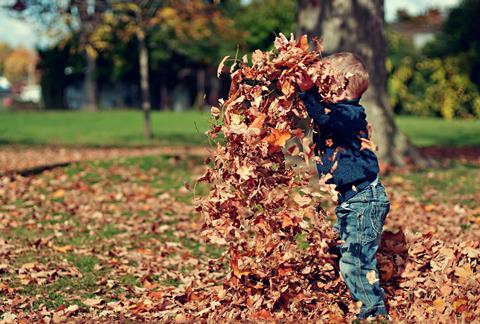Autumn might not be everyone’s favourite season but Gareth Crispin provides reasons for this season to be a great opportunity for spiritual reflection in our families

Autumn always seems to get such a bad rap. It’s the poor cousin of those more popular seasons. Spring is so full of hope, summer is warm and full of holidays and at least winter has got Christmas and sometimes even snow! But autumn … well it’s wet, the nights draw in, the temperature falls and loads of plants die … great!
So is there anything good that can be said about autumn? Well let’s see if we can redeem autumn and help you and your children and young people find joy and hope in the coming months. To do that let’s reflect and act on the following five thoughts……
1. Refreshment comes from rest
In the autumn trees lose their leaves (yep everyday is a school day!). This is their version of hibernation; they’re saving energy. If autumn were a time of day, it would be evening, preparing for the night (winter) with spring being morning and summer the day. The youth and children you know will spend their evenings very differently but eventually they’ll all get ready for bed. It might be later than we think best, they might not brush their teeth but everyone prepares (even if only minimally) to go to bed.
We are part of creation and not immune from the need for good rest
Maybe autumn is a time to help us reset and focus on ensuring our youth and children get good rest. This could mean parents modeling good sleep patterns, but it doesn’t simply have to be about sleep, how about checking phone use - resting is hard when we’re still checking Instagram or TikTok. And what about Sundays? We won’t get into a deep theological debate (maybe another time!) but at a minimum changing the pace of our families’ lives one day a week is worth considering. Lastly, if you lead a church or a youth and children’s ministry and are planning Christmas soon why not think about whether you really have to cram so much into the season, how about deliberately scheduling less and encouraging families to rest together. We are part of creation and not immune from the need for good rest.
2. Sometimes withdrawing is necessary
As well as saving energy, trees losing their leaves means they are protected in the harsh winter. As the rains come and winds pick up, lots of leaves are a hazard for trees increasing the likelihood of being blown over - shedding the leaves and hibernating protects the tree. Youth and children need to know that it’s OK to sometimes retreat and take shelter in life. It will be right to stand out and stand up and confront issues on occasion but at other times it’s OK to withdraw.
Trees seem wise when we look at it like this, they know when to blossom and grow and they know when to stop and take cover
Jesus often confronted people but not always, sometimes he walked past people and away, he withdrew, he was human. Some youth and children might not need any encouragement to withdraw and take shelter for a time, but others might need encouragement to protect themselves sometimes. Think about the youth and children in your care, do they need encouragement to withdraw at some point? If you’re a youth and children’s leader does your zeal for mission sometimes give an unbalanced message? And parents, does your home function as a place of calm in the storm? Trees seem wise when we look at it like this, they know when to blossom and grow and they know when to stop and take cover.
3. We’re not in control but God is
A sense of being out of control plagues youth and children; it’s partly what lies behind the increasing anxiety we see today but also other mental health issues such as anorexia. Equipping youth and children to manage life as adults is of course a key part of helping them grow up but ultimately the answer to life’s problems is not to try ever harder to deal with the problem ourselves but to recognise that we cannot manage, we are not ultimately in control, but we know someone who is. Autumn is a great opportunity to talk about that with youth and children.
Let’s think about being an example to the youth and children we know in showing trust in God to act in his time and not fret
As summer slips away and we return again to those negative comments about the nights drawing in we can engage youth and children with a thought experiment. How might they try to stop the onset of autumn? How about really big lights to keep the days long? How about really big heaters to keep the temperature up? What about sellotaping the leaves to the trees? Yeah exactly. But who made the world so that it moves through seasons in the first place? Who has the power that we lack?
There are lots of passages from the Bible that would be worth thinking about here. Why not read James 5:7-11 with your youth and children and ask them how they feel about being like the farmer who waits for the autumn rains patiently because they can’t make them come. God promises to act when and how is right, including bringing in the new creation where all things are made new. Let’s think about being an example to the youth and children we know in showing trust in God to act in his time and not fret.
4. In times of change some things don’t change
The rate of change in the world seems to get faster and faster as technological developments continue at breakneck speed. Autumn is a particular time of change for youth and children; they enter a new year at school, have new teachers, new timetable, new subjects, new shoes! Of course this can be as much of a challenge for parents as it can be for youth and children but again there is something very positive that we can see in this if only we have eyes to see it. As Noah comes out onto dry land after the flood, God makes several promises to him (and us) - as part of the promise to never flood the earth again God says
“As long as the earth endures, seedtime and harvest, cold and heat, summer and winter, day and night will never cease.” (Genesis 8:22)
Read more:
How Christian families can help shine a light this Halloween
As youth and children process changes in their mind this term, why not ask them if autumn failed to turn up this year, or last year or the year before that and whether spring forgot to follow on from winter in the last few years. Ask them if God will be the same tomorrow, next week and in the years to come? Talk about why that is such a comfort to you.
5. Life comes from death
This last idea is possibly the biggest. What we see in the seasons is a big visual aid of the shape of salvation. We know that as autumn takes hold, death extends its hand into nature, but equally we know what comes next, rebirth and life. This is the Christian story. In the Old Testament the people of God continually turned their backs on him to worship other gods. After a period of great patience, God brought judgment on them, Jeremiah even uses the picture language of autumn to depict this (Jeremiah 8). But this judgment, this death, is not and is never the end of the story. From it God brings rebirth, new life. It’s the shape of the cross and resurrection too - life from death. It is of course the story of every Christian and every church. Have you shared your story of God bringing life out of death in you with the youth and children around you? Or asked them how they see that in theirs?
This autumn why not try planting some sweet peas in pots, you can do this from October time and plant outside in April. You could write John 12:24 on the pots or make a proper sign that can go outside with them when you plant them out. ‘Very truly I tell you, unless a kernel of wheat falls to the ground and dies, it remains only a single seed. But if it dies, it produces many seeds’.
Sure, we can join in with the normal narrative and berate autumn for being a cold, dark time of unsettling change or we could redeem it and help youth and children to see the joy and hope that is hidden in a season that maybe isn’t quite the poor cousin we think it is.
This article was originally published on NexGen Pro in August 2023 and has been re-edited for NexGen in autumn 2025.































